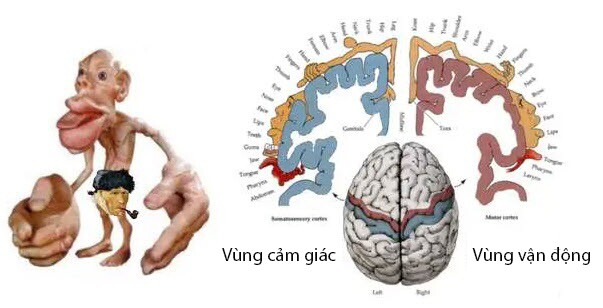To gain a clear understanding of how the human brain perceives and controls the body, Canadian neurosurgeon Penfield created the famous “Penfield Map” (seen on the right) after extensive research, identifying the motor and sensory areas of the brain.
Take a look at the 3D dwarf in the image on the left. His fingers and mouth are disproportionately large, while his limbs and body are thin as a reed. Does this unusual proportion surprise you?

This is because the brain creates a map of the body’s proportions based on the number of neurons dedicated to controlling each body part.
From this, we can deduce that the brain is highly sensitive to information from the fingers and mouth, as they are the first and second most represented body parts on this neural map.
During early development, the brain grows at an astonishing rate, forming tens of thousands of neural connections every second. A child’s exploration of the world through their hands and mouth can stimulate almost all brain regions and deeply engage the entire nervous system.
In other words, a child’s intelligence, brain speed, and potential are greatly influenced by how actively they use these two body parts during their early years.

Hands
The fingertips are the most nerve-dense area of the body. Moving one’s fingers can activate a third of the motor area and a quarter of the sensory area of the brain. Thus, the fingers are often referred to as the “tentacles of the brain.”
Play is a child’s essential job, and developing intelligence starts with the hands. Provide diverse stimuli to the fingertips to encourage brain development and enhance intelligence.
Before the age of three, encourage activities such as coloring, tearing paper, and flipping through books.

The fingertips are the most sensitive part of the body.
After the age of three, children can progress to paper folding, beading, picking up beans, playing with clay, puzzles, and finger exercises.
Any game that involves using the fingers is beneficial, as long as it is safe. For example, with Lego blocks, children must first visualize the final structure and then assemble the pieces accordingly. This process requires hand-eye-brain coordination to determine how to hold and place each block correctly.
Although these actions may seem simple, they promote deep neural connections and enhance cognitive function. Rich and delicate fingertip experiences not only activate thinking but also improve calculation and spatial cognition.
A study by Hiroshima University in Japan found that children with more dexterous fingers tend to have stronger logical thinking and calculation abilities. They are also better at solving math problems and have superior spatial cognition.

Children can explore and learn through finger-focused activities.

Mouth
The area around the mouth has a high concentration of nerves that connect directly to the brain.
When we eat, information is transmitted to the brain through our five senses, activating various brain regions, including the prefrontal cortex, which is responsible for future planning, self-management, and problem-solving, and the hippocampus, which is crucial for memory and spatial cognition.
Additionally, chewing stimulates the development of the masticatory muscles, improving a child’s clarity and strength of speech.
Therefore, encouraging proper chewing from an early age not only benefits the spleen and stomach but also enhances language expression and contributes to a smarter brain.

The area around the mouth is rich in nerves that connect directly to the brain.
During mealtimes, a child’s sense of touch, taste, hearing, sight, and smell are all engaged. The prefrontal cortex provides corresponding instructions on food texture and how to eat it. For instance:
“This food is liquid; you can swallow it directly.”
“This food is mushy; it’s safer to crush it with your teeth before swallowing.”
“This is a bit hard, so you need to chew it with your teeth.”
Thus, when introducing solid foods, experts advise doing so gradually. As children grow, it’s beneficial to include chewy foods in their daily diet, especially at breakfast.
Proper chewing stimulates the brain to release serotonin and increase blood flow to the brain, improving attention and memory. This freedom to cope with various learning challenges.
Indeed, the hands and mouth are the body parts most closely linked to the brain, deeply stimulating most brain regions and igniting countless neural pathways in a developing child’s brain.







































